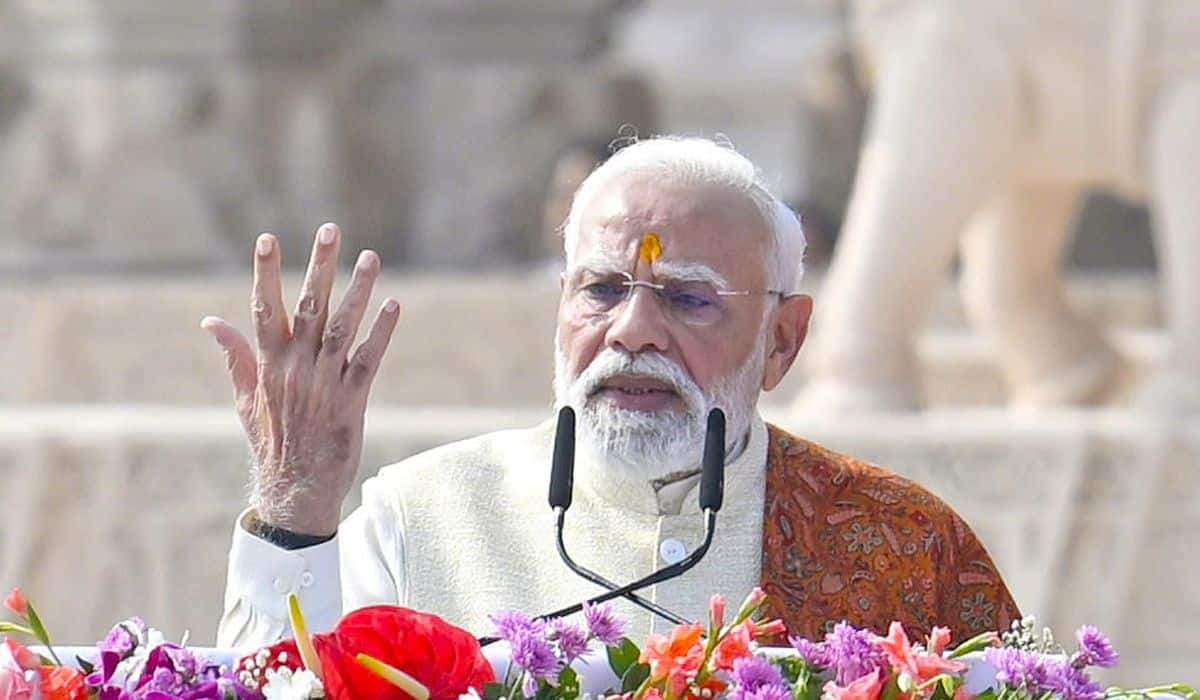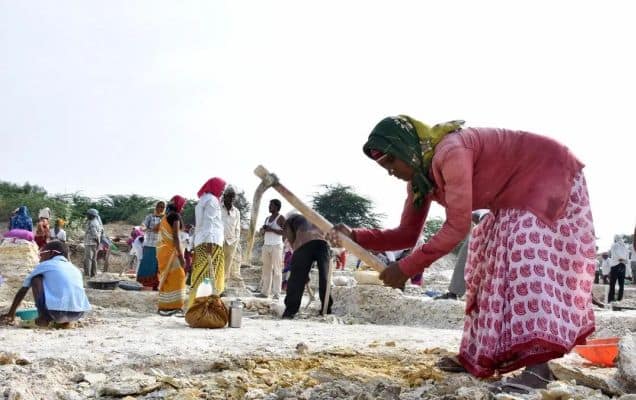मुझे खुशी है कि पहली बार केंद्र और देश की अलग-अलग राज्य सरकारें, टेक्सटाइल इंडस्ट्री से जुड़े लोग एकजुट हुए हैं और इस मेगा इंटरनेशनल इवेंट के जरिए पूरी दुनिया को भारतीय टेक्सटाइल इंडस्ट्री की संभावना दिखा रहे हैं।


टेक्सटाइल एक ऐसा क्षेत्र है जो एग्रीकल्चर और इंटस्ट्री के बीच एक अद्भुत bridge की तरह काम करता है। कपास की खेती हो, सिल्क का उत्पादन हो, इनका end product बहुत कुछ टेक्सटाइल सेक्टर पर निर्भर करता है। किसानों की मेहनत से उपजे raw material को बाजार मुहैया कराने का काम टेक्सटाइल सेक्टर करता है। यानि एक तरह से टेक्सटाइल agro और industry दोनों का ही part है।
भारत के इतिहास में अगर किसी एक इंडस्ट्री का हमेशा महत्व रहा है, तो वो टेक्सटाइल इंडस्ट्री ही है। हजारों वर्ष पूर्व के भारतीय शास्त्रों में वस्त्रों की महिमा का जिक्र होता रहा है। सैकड़ों वर्ष पहले से ये इंडस्ट्री दूसरे देशों के साथ व्यापार का मुख्य आधार रही है। जिन रास्तों से कपड़ों और धागों को दूसरे देश ले जाया जाता था, उन रास्तों के नाम भी किसी ना किसी धागे के नाम पर प्रचलित हो गए थे। इन रास्तों से कितने ही विदेशी दार्शनिक भारत को समझने के लिए यहां आए और भारतीय संस्कृति की महानता का दर्शन करके लौटे। अपने साहित्य में भी उन्होंने भारतीय वस्त्रों और टेक्सटाइल इंडस्ट्री की ताकत को प्रमुखता से जगह दी।

अलग-अलग Time period में हमारे देश के साहित्य में भी इसकी छाप नजर आती रही है। करीब डेढ़ साल पहले चेन्नई में जब पहली बार नेशनल हैंडलूम डे का समारोह हुआ था, उस समय मुझे बनारस के एक बुनकर भाई ने एक Stole दिया था। इसमें कबीरदास जी का एक प्रसिद्ध दोहा हाथ से काढ़ा हुआ था। उस दोहे की कुछ पंक्तियां हैं-
काहे के ताना काहे के भरनी, कौन तार से बिनी चदरिया।

कबीर जो खुद सूत कातते थे, कपड़ा बुनते थे, कपड़ा रंगते भी थे। उन्होंने अपने न केवल काम में जीवन की सच्चाई को तलाशा और उसी से शब्द लेकर अपने दोहों में व्यक्त भी किया।
साथियों, वस्त्र हमारे देश की सांस्कृतिक विविधता से भी जुड़े रहे हैं। या कह सकते हैं कि वस्त्र हमारे देश की सांस्कृतिक विविधता का प्रतीक रहे हैं। कितने ही शहरों और क्षेत्रों की पहचान वहां की टेक्सटाइल इंडस्ट्री से ही है। कांचीपुरम, बनारस या असम का सिल्क हो, कश्मीर का पश्मीना और जामावर का काम हो, बंगाल की मुस्लिन हो, लखनऊ में चिकन का काम हो, ओढिशा और तेलंगाना में हाथ से बुना हुआ इक्कट हो, गुजरात में पटोला हो, ये सैकड़ों वर्षों से अपने-अपने इलाके को पहचान देते रहे हैं। ऐसी विविधता आपको दुनिया में किसी और देश में नहीं मिलेगी।
Ladies and Gentlemen,
India is today described as a bright spot in the global economy. It has emerged as one of the most attractive global investment destinations. This has been made possible by a series of sustained policy initiatives.
More than seven thousand reforms have been implemented to improve the ease of doing business. Processes have been simplified and made transparent. Government has repealed over twelve hundred outdated laws. These are just a few examples.
Consequently, India has moved up by thirty two places in the last two years in the Global Competitiveness Index of the World Economic Forum. This is the highest for any country. India moved up nineteen places on the World Bank Logistics Performance Index of 2016. We have also moved up sixteen places on the Global Innovation Index of the World Intellectual Property Organisation in 2016. We are third among the top ten FDI destinations listed by the United Nations Conference on Trade and Development.
Based on the “Make-in-India” initiative, the organized textile industry is being infused with the mantras of ‘skill, scale, speed’ and ‘zero-defect, zero-effect’ for scaling up employment, production and exports.
We have one of the most liberal investment policies for foreign investment in the textile and apparel sector. We allow 100 percent FDI through automatic route in textile and apparel sector.

Ladies and Gentlemen
The textiles industry has a pivotal position in the Indian economy. It is strong and competitive across the value chain. India has an abundant supply of raw material, like cotton, wool, silk, jute, and man-made fibre. In fact, it is the world’s largest producer of cotton and jute, and second largest producer of silk and man-made fibre. This provides us the distinct advantage of backward integration, which many other countries may not have. In addition, India has strong spinning, weaving, knitting and apparel manufacturing capacities. Young, skilled labour is available at a reasonable cost.
Our high economic growth has resulted in higher disposable income. The resulting higher demand for products offers a huge domestic market. Ours is a nation of aspirational youth, who wish to spend on textiles, apparel, and handcrafted lifestyle products. The domestic market for apparel and lifestyle products, currently estimated at US Dollars 85 billion, is expected to reach US Dollars 160 billion by 2025. This growth will be driven by the rising middle class.
There is also a high global demand for textiles and apparel manufactured in our country. India is the world’s second largest exporter of textiles, commanding a global share of around five percent. Indian textiles, including traditional handloom and handicraft products, are exported to more than a hundred countries. Sometimes, Indian tourists buy garments abroad, only to realize later, that they have been made in India.
The textile sector offers significant employment opportunities. It is today, our second largest employer after agriculture. Over forty-five million people are employed directly in the sector, and over sixty million people are employed in allied activities.
इसी को ध्यान में रखते हुए इस सरकार में टेक्सटाइल सेक्टर पर विशेष ध्यान दिया जा रहा है। पिछले वर्ष एक टेक्सटाइल Package दिया गया है। जिसके तहत apparel और made-up sector को मजबूती दी जा रही है।
सरकार ने तय किया है कि Apparel और Made-up सेक्टर में जो भी कंपनी या कारोबारी नए श्रमिकों को रोजगार देते हैं उन्हें आर्थिक मदद दी जाएगी। लेकिन आर्थिक मदद का तरीका ये होगा कि वो जिस भी कर्मचारी को रखेंगे, उनके Employee Provident Fund में कंपनी की तरफ से जो 12 प्रतिशत राशि दी जाती है, उसे सरकार खुद वहन करेगी। इसका फायदा ये होगा कि ज्यादा से ज्यादा श्रमिक formal सेक्टर में शामिल होंगे।
इसके अलावा सरकार ने Apparel सेक्टर में fixed term employment का भी रास्ता खोला है। यानि ये श्रमिक एक specific time period के लिए नियुक्त होंगे लेकिन इस दौरान उन्हें वही सुविधाएं मिलेंगी तो किसी परमानेंट कर्मचारी को मिलती हैं। इससे भी श्रमिकों की स्थिति में सुधार आएगा।
इनकम टैक्स एक्ट के तहत भी इस सेक्टर की कंपनियों को छूट दी गई है। ऐसी मैन्यूफैक्चरिंग यूनिट्स जहां कम से कम 100 श्रमिक हैं, वो किसी नए श्रमिक को 150 दिन तक रोजगार देती हैं तो भी उन्हें टैक्स में राहत दी जा रही है।
Ladies and Gentlemen
An integrated skill development scheme is also being implemented to address the critical gap of skilled manpower, through industry-oriented training programs.
Our strengths in manufacturing and export are backed up by our ability to develop world-class training and research institutes. The National Institute of Fashion Technology has a network of sixteen professionally managed campuses. It has been playing a crucial role in benchmarking performance and processes in the areas of fashion education, research and development, training and consultancy.
In the last few years we have witnessed a very healthy competition amongst States to attract investment and industries in their respective States. As a result, there have been some major reforms that have taken place in States. Each State in its own way has tried to facilitate the establishment of new industries including textiles. I think, the time has now come for us to concentrate on textile exports in a big way.
India is a country with diverse culture, fashion and traditions. This diversity is clearly reflected in the clothing present in different regions. We should catalogue and map our clothing diversity and clearly earmark strengths and specialties of each state or region. Each State should appoint nodal officers dedicated to a few well-known products, who would facilitate producers and traders across the value chain. The intervention should start from production to export of garments. It should meet the specific requirements of domestic as well as export markets.
We should also formulate an action plan to study and map the requirements of people in large global markets and monitor new trends in fashion and textiles in these areas on a real time basis. Government Councils and Industry Bodies should rise to the occasion, in a spirit of cooperation. This would enable us to channelize our energies in meeting those requirements and give a boost to our exports.
Friends
Innovation and research are new mantras for growth and wealth generation. The textile industry will have to constantly innovate and research for growth and to tap new markets. For example, physiques may be larger in some parts of the world. This may require clothing of greater width than the normal size used in our country. For this, you may need to increase the width of the loom. Elsewhere, requirements may be different. Such attention to detail is necessary to attain leadership in export markets.
Today, there is a demand for products with zero carbon footprint. Holistic lifestyle has become a buzzword. The market for Organic Dyes, clothes and fabrics made of organic products is growing. Our effort should be to innovate in organic products.
Apart from cotton and jute, we already have fabrics made of banana and bamboo fibres. There is a niche market for such products. Thus, there is a need for further research by our institutions like National Institute of Fashion Technology and Scientific and Industrial Research institutes to develop fabrics from other sources.
Ladies and Gentlemen
Our integrated textile clusters are compliant to global standards of environment and health safety. Textile producing States also have pro-industry policies in place, to facilitate the required infrastructure for investments in textiles.
I understand that over the next two days, you would have an opportunity to interact with a few State Governments. Some of my Cabinet colleagues will also interact with you. I am sure you will find these sessions interesting and informative.
I hope this event will help familiarize global and Indian leaders with India’s enabling policy environment, strengths and vast opportunities associated with the sector. This will help establish India as a valued partner for countries seeking sourcing and investment opportunities in India. I hope, it will go a long way in realizing India's inherent potential to become one of the most significant textile and apparel sourcing and investment destinations.
Ladies and Gentlemen
Let me conclude by wishing you a very successful and productive three days in Gandhinagar.
I call upon you to Come, Invest and Make Textiles in India.
Thank You!
PM @narendramodi is speaking at the inaugural function of #TextilesIndia2017
— PMO India (@PMOIndia) June 30, 2017
Watch Live https://t.co/vbG9VFN31Q
वस्त्र हमारे देश की सांस्कृतिक विविधता का प्रतीक रहे हैं। कितने ही शहरों और क्षेत्रों की पहचान वहां की टेक्सटाइल इंडस्ट्री से ही है: PM
— PMO India (@PMOIndia) June 30, 2017
India is described as a bright spot in the global economy. It has emerged as one of the most attractive global investment destinations: PM
— PMO India (@PMOIndia) June 30, 2017
Based on #MakeInIndia, the textile industry is being infused with the mantras of 'skill,scale,speed' & 'zero-defect,zero-effect': PM
— PMO India (@PMOIndia) June 30, 2017
The textile sector offers significant employment opportunities. It is today our second largest employer after agriculture: PM @narendramodi
— PMO India (@PMOIndia) June 30, 2017
We should catalogue & map our clothing diversity & clearly earmark strengths & specialities of each state or region: PM
— PMO India (@PMOIndia) June 30, 2017
#TextilesIndia2017
I hope this event will help familiarize global & Indian leaders with India’s enabling policy environment, strengths & vast opportunities: PM
— PMO India (@PMOIndia) June 30, 2017














